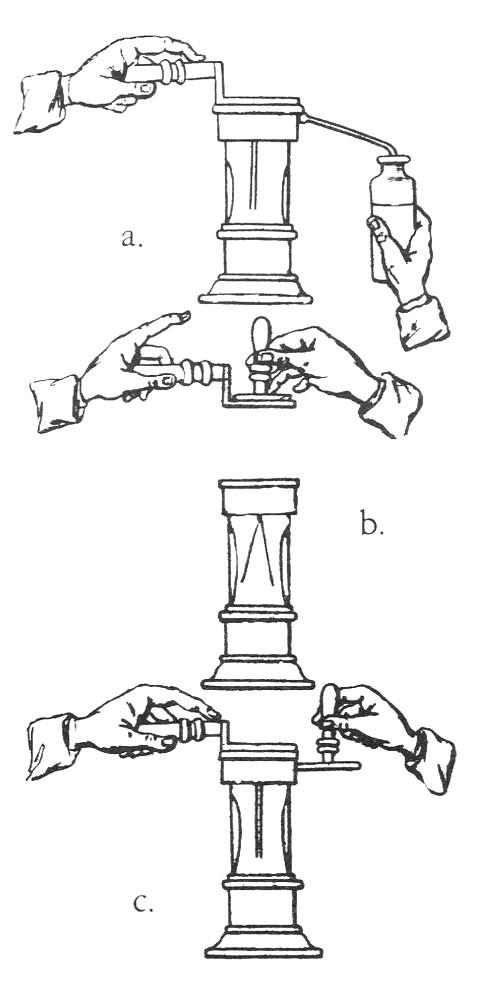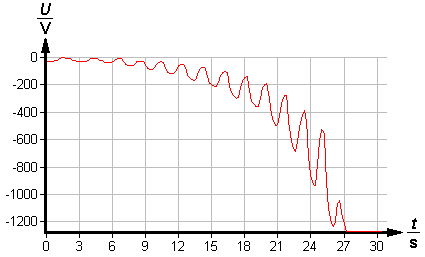Bennet's doubler
 Bennet's
doubler [p88][4][37][56]
is a clever
device for the
continuous doubling of an initial small charge through a sequence
of operations with three plates. It was
invented in 1787 by the Reverend Abraham Bennet, that used it for
studies about the electric state of the air. The figure shows the
original implementation, using Bennet's gold foil electroscope covered
with a
metal plate and two other metal plates with insulating handles. The top
plate has its handle attached to its center, and the central plate has
it attached to its side, as shown. The top
and central plates have their undersides varnished for insulation
Bennet's
doubler [p88][4][37][56]
is a clever
device for the
continuous doubling of an initial small charge through a sequence
of operations with three plates. It was
invented in 1787 by the Reverend Abraham Bennet, that used it for
studies about the electric state of the air. The figure shows the
original implementation, using Bennet's gold foil electroscope covered
with a
metal plate and two other metal plates with insulating handles. The top
plate has its handle attached to its center, and the central plate has
it attached to its side, as shown. The top
and central plates have their undersides varnished for insulation
a) An initial charge is applied to the electroscope, with the
central plate over it, grounded by a touch by the operator but
insulated by the varnished surfaces. (This is the same initial
operation of Volta's "condenser electroscope", and
attracts to the electroscope much more charge than it's body only
would attract.)
b) The central plate is moved away from the electroscope (causing
an increase in the voltage between them, visible by the
separation of the electroscope foils), and the top plate is used
as an electrophorus over it. When the top plate, positioned over
the central plate but insulated from it by the varnish layers, is
touched by the operator, an inverted copy of the charge in the
central plate appears on it.
c) The charge in the top plate is added to the electroscope's
charge by conduction when they touch, attracted by the central
plate, that is again placed over the electroscope and touched by
the operator. The charges in the central plate and in the
electroscope are doubled.
The process (b, c) can be repeated any number of times, doubling
the electroscope's charge, or almost, at each step, as can be
verified by the approximate doubling of the divergence at the
electroscope. The multiplication ends only when sparks or corona
start to drain the charges away.
The doubler is an instrument to measure small charges, turning them
visible in the electroscope. A problem is that natural initial charges
are easily multiplied in this way, and charges are generated by any
rubbing of the plates, making
the doubler imprecise for measurements requiring many doubling steps.
In a few cycles, visible
charges can be produced in the electroscope starting from
apparently discharged plates. The idea can be used as basis for a
self-starting electrostatic influence generator. Curiously,
except for some simple direct mechanized versions, also designed as
measuring instruments, as the
revolving doublers developed by Nicholson
and Bohnenberger, the principle
was never used in more powerful influence machines.
A working model
In April 2000 I built a model of
Bennet's doubler. I first made a simple electroscope using an
acrylic box, with two light plastic foam balls suspended from
thin wires as charge detector. The balls were painted with nankin
(china) ink to become conductive, and the wires were suspended by
small hooks from a small wire ring connected to a brass bar
inserted in the top plate of the electroscope. I cut away the
bottom of the plastic box, replacing it with a wooden base, and
glued two aluminum foil disks to the internal sides of the box,
to avoid charge accumulation inside the box. The top plate of the
electroscope and the other two plates of the doubler were made
from wood disks, with a light layer of varnish, insufficient for
insulation. The wood plates are conductive enough for this
purpose, but don't produce visible sparks. I glued two plastic
disks to the central plate to serve as effective insulators, and
omitted special insulation of the surfaces of the other plates.
The two plates received handles turned from nylon (a bad choice.
The handles become too conductive after some time, and I had to
replace them by polished PVC tubes to make the doubler work
again). The device is charged by a sequence
of operations, as shown above. It can be operated with one hand, as I discovered while trying to
take these pictures, holding the camera with the other hand, but
with two hands the operation is more practical, and it's more
easy to avoid mistakes in the sequence (It was said that Bennet's
doubler "multiplies electricity at the cost of mental as
well as mechanical energy" [37]).
It never fails to charge from nothing to the saturation of the
electroscope (~5 kV) in 10 to 20 operations. With dry conditions,
once the set is charged, the top plate can be used as an
electrophorus over the central plate, or the central plate can be
used with the electroscope, producing charges of both polarities
for other experiments. It's possible to revert the polarity of
the electroscope by conduction, by discharging it and touching it
with the charged central plate, or by influence, by touching it
while the charged top plate is held close to it.
With wooden plates, the doubler can
easily get charged by
friction between the plates, specially if the central plate is
touched and frictioned against the electroscope plate.
Apparently, the plastic disks (polyethylene?) used produce good
charge when frictioned against partially varnished wood. This is
actually a convenient way of charging the electroscope, but is
not the idea of the doubler. By 2002, I made another set using
wood plates covered with aluminum foil and acrylic disks, that
doesn't get charged by friction, but works in the same way and
can produce small sparks. I made also another set with wood
disks, but using a different varnish, that doesn't get charged by
friction.

The picture above shows the voltage at
the electroscope, as
measured using a high-impedance voltmeter (Phywe
elektrofeldmeter), for negative charging. The doubling at each
cycle is incomplete due to losses and to the loading due to the
meter capacitance. The operation was interrupted at -1200 V, the
meter limit, but the doubling could continue to about -5000 V.
A document, in Portuguese, describing
the construction of an
improved Bennet's doubler. For automated
versions of Bennet's doubler, see Nicholson's
revolving doubler, and Bohnenberger's
machine.
This is a video
showing a Bennet's doubler made with wood disks
covered with aluminum foil in operation. The lower plate is put over
an insulated metal plate, and an electroscope measures the potential
in the plate.
A similar video,
in Youtube, with a wooden doubler. Several other videos with doublers
can be seen in the same account too.
Created: 3 April 2000
Last update: 6 April 2012
Developed and maintained by Antonio Carlos
M. de Queiroz.
Return to Electrostatic
Machines
 Bennet's
doubler [p88][4][37][56]
is a clever
device for the
continuous doubling of an initial small charge through a sequence
of operations with three plates. It was
invented in 1787 by the Reverend Abraham Bennet, that used it for
studies about the electric state of the air. The figure shows the
original implementation, using Bennet's gold foil electroscope covered
with a
metal plate and two other metal plates with insulating handles. The top
plate has its handle attached to its center, and the central plate has
it attached to its side, as shown. The top
and central plates have their undersides varnished for insulation
Bennet's
doubler [p88][4][37][56]
is a clever
device for the
continuous doubling of an initial small charge through a sequence
of operations with three plates. It was
invented in 1787 by the Reverend Abraham Bennet, that used it for
studies about the electric state of the air. The figure shows the
original implementation, using Bennet's gold foil electroscope covered
with a
metal plate and two other metal plates with insulating handles. The top
plate has its handle attached to its center, and the central plate has
it attached to its side, as shown. The top
and central plates have their undersides varnished for insulation